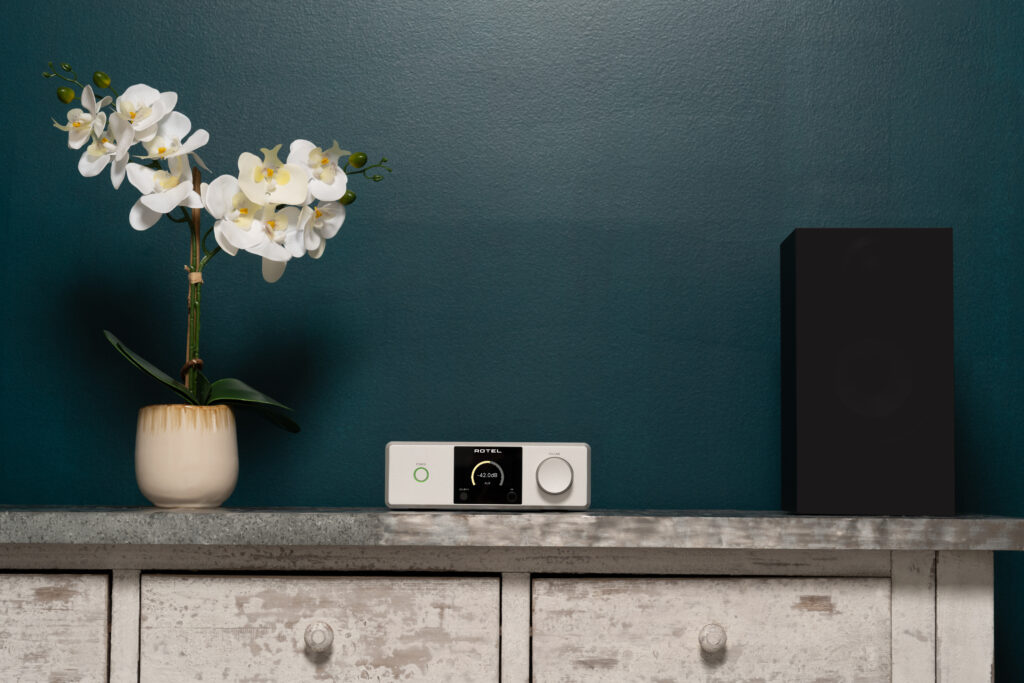Rotel DX-5 Stereo Integrated Amplifier – a sleek integrated amp that delivers 33 Watts/channel into 4 ohms (25 Watts/channel at 8 ohms) via a class AB internal amp. The 768kHz ESS ES9039Q2M Sabre DAC ensures ultra-low noise (100 dB SNR) and a wide soundstage (10 Hz – 100k Hz, ±0.19 dB). While an external DAC can be used, this digital to analog (DAC) chipset is a rock solid one for audiophile purposes and allows digital input right into this integrated amp.
Versatility abounds with HDMI ARC for seamless TV audio, a subwoofer output for 2.1-channel setups, and a headphone jack for private listening. Connect via PC-USB (32-bit/384kHz PCM, DSD 4x), Coaxial/Optical (24-bit/192kHz), aptXTMHD/AAC Bluetooth, or RCA analog inputs. Roon Tested certification enhances your high-res music experience, while the precision volume control (0.5dB steps, 680 mV sensitivity) has a solid feel.

Weighing 4.1 kg, the DX-5’s compact design (215 x 76 x 251 mm, 8 1/2 in x 3 in x 9 3/4 in) features a full-color TFT display and an aluminum remote, blending elegance with intuitive controls. Available in black or silver.
Suggested Retail Pricing
DX-5 USD $1,499.00
Shipping and Market Availability
Products will be available in North America, Europe and the UK in April 2025 with the rest of the world to follow soon after.
The Audiophile History of Rotel
Rotel is a name that may not command the attention of the average consumer, but in audiophile circles, it has earned steady respect over decades. Rather than relying on marketing flash or extravagant pricing, Rotel has consistently focused on delivering well-engineered audio components with an emphasis on value, reliability, and sonic integrity. For over 60 years, the company has served listeners who care more about how their music sounds than what brand name is printed on the front panel.
Origins in Japan
Rotel was established in 1961 by Tomoki Tachikawa in Tokyo. Like many Japanese electronics firms of the post-war era, Rotel started by producing OEM products for other companies. Before long, it transitioned into building its own branded products. The focus was never on being the most luxurious or innovative, but rather on creating thoughtfully designed components that performed well and were accessible to a broad range of music enthusiasts.
Growth in the West
By the 1970s and 1980s, Rotel had developed a presence in the U.S., Canada, and Europe. The brand gained traction in the UK in particular, where its straightforward, no-nonsense engineering approach appealed to a segment of listeners who prioritized transparency and signal purity over features or styling. In the U.S., Rotel became known as a brand that offered performance that outpaced its price, often recommended by dealers who were looking for reliable gear that didn’t generate service calls.
Rotel products often paired well with British speakers like Bowers & Wilkins (B&W), and this sonic compatibility would eventually become a formalized relationship. B&W took on distribution of Rotel in several markets and also offered input on product voicing—a collaboration that would last for decades.
Michi and the Move Upmarket
In the early 1990s, Rotel launched a higher-end product line called Michi. These components were engineered to stricter performance standards and featured more robust power supplies, chassis construction, and overall refinement. The original Michi products were well-received in enthusiast circles, though the line was ultimately short-lived.
Rotel revived the Michi name in 2019 with a new lineup of integrated amps and pre/power separates. These modern Michi products maintained the brand’s design discipline while integrating current-generation features like high-resolution digital inputs and improved industrial design.
A Longstanding Bowers & Wilkins Partnership
Rotel’s technical collaboration with B&W became one of its defining strengths. The two companies shared a philosophy rooted in measured, neutral performance. This partnership helped refine the sound of Rotel products over the years, ensuring they remained consistent and dependable choices for a wide range of speakers. Having access to B&W’s listening panel and acoustics team was a significant advantage during product development, even if neither company pushed that fact as a marketing tool.
The Sound and the Build
Rotel products tend to have a clear, balanced sonic character. They’re rarely described as overly warm or bright, which is one reason they remain popular with listeners seeking neutrality. Their amplifiers, such as the long-running RB series, are known for delivering solid current with good control, making them suitable for a variety of loudspeakers, including those that present challenging loads.
Rotel also stands out for the amount of in-house manufacturing it continues to perform. Many of the brand’s toroidal transformers are still hand-wound in its own factory, and assembly takes place under its own quality control systems. In an era where outsourcing is the norm, this level of vertical integration helps maintain performance consistency across product lines.
Transitioning to the Digital Age
Rotel was deliberate in its approach to digital audio and streaming. While some competitors rushed to add features, Rotel took its time to implement high-performance DACs and modern connectivity options without compromising the design of the analog signal path. Today’s models, like the RA-1592MKII, offer USB DAC inputs, Bluetooth, and even support for MQA and Roon integration, aligning the company’s traditional design goals with modern expectations.
Consistency Over Flash
What defines Rotel more than anything is its consistency. Across decades, product cycles, and shifts in consumer behavior, the company has remained focused on the core of two-channel audio. There’s rarely a dramatic departure from what came before, which makes it easy for longtime customers to upgrade without worrying that the sonic character or reliability has changed significantly.
Rotel doesn’t often make headlines, and it doesn’t market itself as a luxury brand. But among audiophiles who want reliable gear with solid engineering and a track record for value, it’s one of the more trusted names in the industry. The company’s longevity is not based on trends or hype, but on careful design choices and attention to build quality—an approach that continues to resonate with a certain kind of listener.



